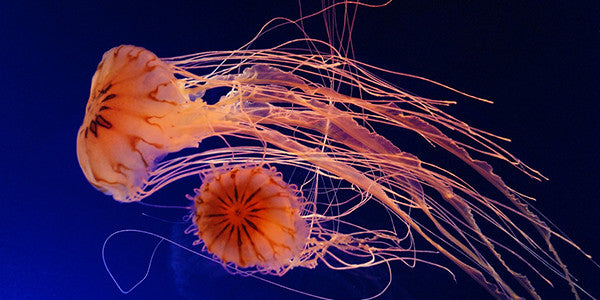Jellyfish Sting Prevention & Treatment

Jellyfish are among the most ancient, beautiful and misunderstood creatures on the planet. Jellyfish have delicate bodies, but their stings can be extremely painful or even deadly so it’s a good idea to educate yourself about how to avoid and treat those stings before you hit the water. Spoiler alert: urine won't help.
PREVENTION IS BEST
While jellyfish stings are rarely deadly, the pain is excruciating. Preventing stings is always better than treating them after the fact.
1. Do some research to ensure you’re avoiding jellyfish-infested waters.
There are many areas where jellyfish are not commonly found in the shallows at all, and others where the presence of jellyfish populations is seasonal. If the shoreline you’re headed to has a manned park ranger or lifeguard station, you may be able to find a phone number for it to call and ask about the presence of jellyfish. You can also do an internet search on the name of the beach or area you intend to visit plus the word “jellyfish” to find articles about jellyfish sightings and incidents in that area.
In waters known to host large populations of jellies at certain times of year, local officials will often provide a jellyfish forecast. If so, you can find it by searching online for the name of your destination plus “jellyfish forecast”. In the U.S., purple warning flags are sometimes flown on the beach to let the public know jellyfish are present.
2. If the water’s cool, wear swim pants or swim tights and a long sleeved swim shirt.
Stretchy, Lycra garments specially made for water wear provide a comfortable barrier that protects against stings and the sun’s UV rays.
If you suspect contact with jellyfish while wearing such garments, remember to be very careful when changing out of them. Any bits of tentacle clinging to the garments will still be capable of stinging.
3. If you don’t want to wear swim garments, use Safe Sea® jellyfish repellant lotion.
Safe Sea® is a recently-developed product and a major breakthrough that offers four mechanisms for preventing and reducing stings from jellyfish and other aquatic creatures.
First, it creates a slippery micro-layer on the skin that prevents tentacles from adhering.
Second, it absorbs or blocks skin secretions that would normally signal the stinging creature to a potential meal. This tricks the creature’s senses into thinking they’ve touched something non-organic, and therefore inedible.
Third, it diminishes pressure in the stinging cells so they cannot fire efficiently or at all.
Finally, if a sting should still fire, Safe Sea® interrupts the chemical messages that tell the body it’s been stung in order to reduce or eliminate pain and inflammation.
TREATING JELLYFISH STINGS
Even though most jellyfish stings are not fatal, it’s important to be alert to any signs of serious trouble. If the victim has lost consciousness, is showing signs of shock (such as pale skin, shallow breathing and disorientation), is experiencing a rapid heartbeat that persists even after the initial scare of being stung, or is stung over a large area of the body or most of an entire limb, don’t take any chances: call for emergency medical aid immediately.
If there are no signs of a medical emergency, the best way to treat the sting of a jellyfish or other aquatic creature topically is with lidocaine spray.
This type of anesthetic spray is available over the counter at drugstores, pharmacies and supermarkets, and is often sold as a sunburn relief spray. Check the label to ensure lidocaine is listed as the active ingredient. Always keep a can of the spray on hand when you’re headed to areas where you may encounter jellyfish or other stinging creatures.
Spray the affected area liberally. The numbing effect will instantly relieve the victim’s pain, but more importantly, if any bits of tentacle are clinging to the skin it will (at least temporarily) disarm any unfired stinging cells. Once the victim’s pain has subsided, use a plastic ID card or credit card to gently scrape any remaining bits of tentacle off the skin. Be careful to avoid touching the tentacles when cleaning off the card, and dispose of them properly: wadded up into the center of the tissue, paper towel or cloth you used to clean off the card, to ensure no one else is likely to come in contact with them. When you’re sure all tentacle bits have been removed, rinse the skin in cool water, gently blot dry, and re-apply the lidocaine spray.
Urine Will Not Help, and Neither Will Most Other Home Remedies
Urinating on a jelly fish sting will not neutralize it or relieve the pain.
Vinegar has been shown to neutralize the stings from certain kinds of jellyfish, but for other types of jellies it can actually make more stinging cells fire and regardless, it will not lessen the pain of a sting.
A fresh water rinse, at any temperature, will make more stinging cells fire as they react to the different chemical make-up of the rinse water versus the water they came from.
A paste of baking soda and sea water has been shown to help neutralize stings and offer some pain relief for certain types of jellyfish, but not all. And who keeps a box of baking soda in their beach bag?
Keep it simple and stick with what works in all cases: lidocaine spray is the only surefire fix for minor jellyfish stings.
- Watersports Staff






Comments 0